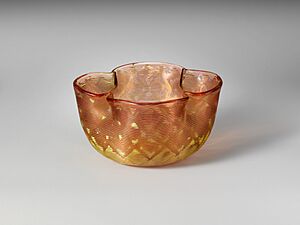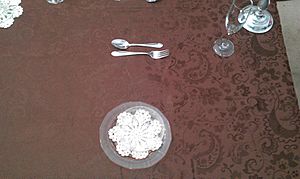Finger bowl facts for kids
A finger bowl is a small bowl filled with water. Guests at a meal use it to rinse their fingertips. It's a way to keep your hands clean during or after eating, especially when you've eaten foods that might make your fingers sticky or messy.
Finger bowls are usually part of more formal meals, like fancy dinners. But they can also be used in less formal settings, especially if you're eating foods with your hands.
Contents
What is a Finger Bowl?
A finger bowl is a small, shallow bowl. It holds a little bit of water. Sometimes, a slice of lemon, a flower petal, or a small sprig of mint floats in the water. This makes it look nice and can add a fresh scent.
The main purpose of a finger bowl is for hygiene. It lets you quickly clean your fingers without leaving the table. This was very common in the past, especially when people ate more foods with their hands.
Using a Finger Bowl at Formal Meals
At a very formal dinner, the finger bowl usually arrives with the dessert. It might be placed on top of your dessert plate. There's often a small, decorative mat called a doily under the bowl. Your dessert fork and spoon might be placed next to it.
When the finger bowl arrives, you gently move it. You take the dessert fork and spoon and place them on either side of your dessert plate. Then, you move the finger bowl and its doily to the upper left side of your plate. This clears space for your dessert.
After you finish eating dessert, or the very last course, you use the finger bowl. You dip the fingertips of one hand into the water, then the other. You don't wash your whole hand. After dipping, you gently dry your fingers on your napkin, which should be on your lap.
Special Formal Occasions
Sometimes, if a fruit course comes after dessert, the finger bowl might arrive with the fruit plate instead. The idea is always to have it ready for the very end of the meal. This way, you can clean your hands just before you leave the table.
It's important to remember that you only dip your fingertips. You don't drink the water! Also, if there's a lemon slice or flower, you don't eat it. These are just for decoration.
Using a Finger Bowl at Informal Meals
Finger bowls can also appear at less formal meals or in restaurants. In these settings, they might be brought out after any course where you've used your hands. For example, if you've eaten messy finger foods like ribs or lobster, a finger bowl helps you clean up.
In some restaurants, especially older ones, finger bowls were a sign of good service. They showed that the restaurant cared about the comfort and cleanliness of its guests.
Common Mistakes
Because finger bowls are not as common today, some people might not know how to use them. Common mistakes include:
- Drinking the water.
- Eating the decorative items like a lemon slice or flower.
- Not moving the doily with the bowl when you shift it.
These are just small mistakes, but knowing the proper way to use a finger bowl can make you feel more confident at a fancy dinner!
Why Finger Bowls Became Less Common
Finger bowls were very popular in the past, especially in the early 1900s. They were seen as a fancy touch at restaurants and homes. However, their use started to decline around the time of World War I.
During the war, people were encouraged to save resources and avoid anything seen as "extra" or wasteful. Finger bowls, being a luxury item, started to disappear from many places. Over time, as dining habits changed and more people used forks and knives for most foods, the need for finger bowls also decreased.
Even though they are less common now, finger bowls are still used in some very formal settings or traditional restaurants. They are a reminder of older dining customs and a way to add a touch of elegance to a meal.




